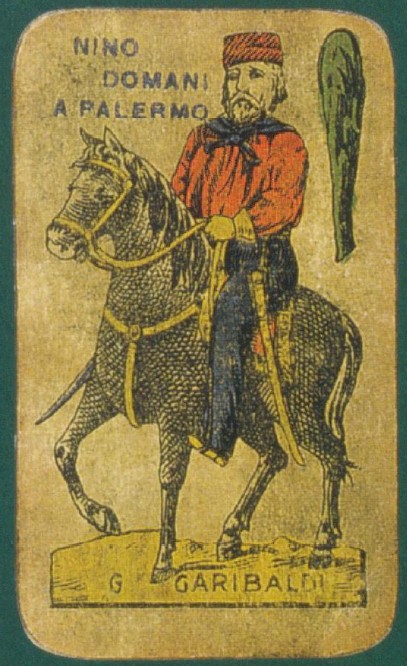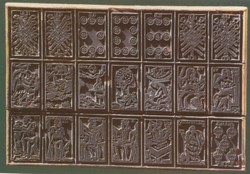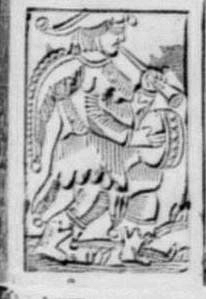|
About 20 years ago, when I was more active in my research on the history of games, I took the opportunity to visit public archives and libraries in a lot of towns. Palermo has been one of them. Starting from Florence, it is about as far as Paris (where I arrived too in my visits) – this means that it is not surprising that only once and only for about a week I visited the three main locations in Palermo: Biblioteca centrale della regione Sicilia "Alberto Bombace", Biblioteca comunale in Casa Professa,(1) and Archivio di Stato. All of them are in the old part of the town and walking in the surrounding district (with a satisfactory knowledge of what it had been in the past centuries) was a pleasant experience, also from the touristic and photographic point of view.
In this research, I could examine in Casa Professa (the former Jesuit college) the manuscripts of Francesco Maria Emanuele e Gaetani, Marchese of Villabianca (1720-1802), which represented one of the most useful bases for the pioneering work of Michael Dummett.(2) I didn’t have time enough for an exhaustive search, especially in the ASPa; in any case, I was able to find several small new information for the history of chess,(3) and also for the history of cards.(4)
Recently, my interest on these topics seems to have experienced a rebirth, but even if I love the ancient part of Palermo, I am at present not stimulated enough to come back there for continuing my research on old Sicilian games, and playing cards in particular. Now, I am interested in continuing my research on Florentine games and these I am studying in the libraries and archives of my own town.
One of these days, however, I bumped into a journal article(5) that may provide useful information to interested card historians, even without forcing a new visit of mine in the Sicilian archives. Kalós is a Sicilian quarterly journal, usually published with an extension entirely dedicated to the life and works of a Sicilian artist of nowadays, or to one of the many interesting places of Sicily. Its first year was 1989, and it is published still now.(6) They state that this journal is the most read in Sicily among all those published in the region.
Each article deals with a typical aspect of the Sicilian art or culture, from archaeology, to fine arts, to local habits of the past. It is thus not too surprising that, after more than a dozen years of publication, a specific article of six pages has been printed there on Sicilian playing cards and card games. The greatest part of the article illustrates the local aspects of the most recent centuries, including colour reproductions of typical cards, names of card games, and even words used in playing, hardly understandable by any non-Sicilian people. A few more or less curious anecdotes are also reported.
On the whole, we have an article of local interest, whose most evident merit appears to be the high quality of the publication. We cannot claim that it can be compared with those academic contributions which deal with the matter in a high "scientific" way. All of us interested in these topics are accustomed by now to the writings of university researchers of history, and art history in particular. Not only, even within the restricted field of card collectors and experts we can read with pleasure the contributions of such writers as Dummett or Depaulis, so rich in erudition.
This article is not of that kind. Why I am then devoting my special attention to it? The answer is simple. I hand down to any interested reader the task to check in person the last part of the article, but I feel necessary to spread in the world of card collectors what this author tells us about the first times of the diffusion of playing cards in Sicily.
Let me list here the corresponding dates, which can be found in the initial part of the article:
- 1482: Franco Olivier from Malta was fined because he had been found to play the forbidden game of naibi or carte.
- 1485: Death of Raimondo de Sezana, French. He had a factory of playing cards in Palermo.
- 1562: Vincenzo Siviglia produces playing cards in Palermo, San Francesco district.
- 1595: Francesco Bova becomes "arrendatore", namely he is officially charged as the responsible in the whole country of the production and trade of playing cards (with taxes going to the Regia Corte).
- 1630: Girolamo Sanna dies in Palermo and among the goods found at his factory there are "200 figuri di tarocchi tagliati et pinti" (200 figures [probably, but not certainly, the triumphal cards of the pack] of tarots cut and painted).
There is unfortunately no reference to their archival sources, but it seems to me that these cannot be imaginary data. This author was at the time a school professor having obtained his PhD degree in medieval history. In conclusion, I think that his information is fully reliable.
In these data, we find more than one surprise. One may be the fact that the manufacturing of cards was (also) in the hand of a Frenchman. Among foreign people it was usually a German maker to be indicated as active in Italy. We know, however, that in the South of France the manufacturing of cards was early active and that cardmakers guilds even worked under strict rules.(7)
Among the playing cards imported in Rome which were recorded at the Roman customs, some were explicitly designated as of French origin, brought by a Frenchman. Another merchant was indicated as Johan de Pino, which can easily be recognized as a de Pineau, not exactly - as it was found for most other merchants - a Florentine family name.(8) (It seems moreover possible to me that the name of Sezana should instead be referred to Cesana, in Savoy, instead of France; not too big a difference, seen from Palermo.)
Another surprise may be the concession given to Francesco Bova, mainly due to its early date.
Maybe the greatest surprise is however the 1630 date for Tarocchi; curiously enough, it is the latest date quoted that appears to be earlier than one could expect. In principle, this date cannot be considered too early, if one compares it with the 1442 year of the first document known, from Ferrara. In two centuries, many events can occur, and it is not easy to imagine a diffusion of any fashion game requiring so long a time in order to cover that distance (even without the bridge on the Messina strait, now under project).
I had verified on Villabianca manuscripts the version given by Dummett, but now we find in a popular journal that Tarocchi were manufactured in Palermo earlier than they were reportedly introduced by Francesco Gaetani, Duke of Sermoneta, who arrived in Sicily as Viceroy in 1663.
Anticipating the initial date by at least 33 years is not a little step, but this change of view has a deeper meaning. We had accepted that a single personage could introduce a new game, due to his high social rank. Fact is that for such personages it is much easier that the corresponding events are recorded and the documents kept and conveyed into the books – ordinary life has less opportunity to occupy the scene, but may be more fundamental than one can suppose at first sight, precisely as it has occurred in Palermo for the introduction of Tarocchi, discussed here. Our Viceroy could at most change parts or figures of an already existing tarot pack.
If tarots were produced locally, little imagination is required to suppose that some pack imported from other places could have arrived earlier; but, even in considering only the new information acquired, we have to reflect that this was not associated with the opening of a new factory – it was instead linked to the death of a maker, who nobody knows how long before could have implemented his Tarot production. In conclusion, and broadly speaking, the date of the introduction of Tarot into Sicily can be set at least a half century backwards in time with respect to the current estimation.
APPENDIX
(The following text has been taken from Kalós. With respect to the journal article I have postponed the two last paragraphs here.)
- L’industria delle carte da gioco era già diffusa nell’isola nel XV secolo. In quel tempo le carte si chiamavano naibi; sappiamo infatti che nel 1482 Franco Oliver di Malta repertus in flagrante luderi a li naibi seu a li carti contra bannum veniva condannato a pagare 4 onze di multa.
- Nel 1485 moriva a Palermo il francese Raimondo de Sezana titolare di un laboratorio di carte da gioco.
- Nel 1562 mastro Vincenzo Siviglia fabbricava carte nella contrada di S. Francesco a Palermo.
- Poi si ha notizia che nel 1595 la Regia Corte concedeva la gabella "paginarum ludi" in arrendamento a Francesco Bova e che questo faceva società con Guerrino Orlando per fabbricare e vendere il prodotto.
- Nel 1610 la "maestranza delli cartari che fanno carti di giocare" chiedeva al Senato di Palermo l’approvazione dei suoi statuti allo scopo di regolamentare l’accesso alla corporazione. L’esame di ammissione richiedeva la capacità di "fari la cartoni, di incollarli bene, di stampare et coprire, tagliare et asupliri li carti … et maxime cusiri bene li coperti che non resti nixuna piega seu macula e segno di una carta ad un’altra nella parte di sopra et anco nello stampare". I maestri che non riuscivano a superare l’esame potevano esercitare il mestiere di "fare moscalori et frixi stampati (muscalurara)". I mazzi di carte nuovi ed usati venivano quindi venduti dai merceri.
- Per la fabbricazione delle carte si adoperava carta proveniente dal continente, come dimostra l’inventario ereditario del cartaio Girolamo Sanna, morto a Palermo nel 1630: "74 risimi di carta di Genova, 13 mazzi di carta di Venezia, 30 mazzi di carta fina della Balestrina di Genua, un cantaro di carta bastarda e reale scritta, 8 quaterni di cartuni di carta di Genua". La produzione di bottega di questo mastro cartaro doveva essere consistente perché alla sua morte lasciava "58 zuzane (dozzine) di carti tra grandi e piccoli fini et carovani menzi incompliti, 10 para di carti spagnioli inconpliti, 200 figuri di tarocchi tagliati et pinti, 24 para di carti larghi menzi compliti, tri para di carta spagnioli abbullati’ e numerosi altri cartoni stampati e non tagliati.
- Egli lasciava al fratello Francesco "tutti li stampi di legnami di arti di ioco grandi e piccoli, li tilara, lo sacco di lo fumo, li allixiaturi e raspi e balati di allixiari". Tra gli altri strumenti di lavoro figurano inoltre "sei para di forfici" per tagliare i fogli stampati, "dui lembi per acquarelli di virdirame, un cantaro e 29 rotula di gomma rabbica, 13 maczi di insiti di fari pinzelli (peli per pennelli)".
Footnotes:
(1) Webpage Biblioteca Comunale di Palermo in Casa Professa
(2) Michael Dummett, The Game of Tarot. Duckworth, London 1980.
(3) Scacco, Vol. 23 N. 7 (1992) 322-323.
(4) The Playing-Card, Vol. XXI No. l (1992) 9-15.
(5) Francesco Lo Piccolo, Giochi di carte in Sicilia dal XV al XX secolo. Kalós, Vol. XIV No. 4 (2002) 34-39.
(6) Webpage Kalós, edizione d'arte
(7) Jean-Michel Mehl, Les jeux au royaume de France. Fayard, Paris 1990. pp. 159-164.
(8) Arnold Esch, Economia, cultura materiale ed arte nella Roma del Rinascimento. Roma nel rinascimento, Roma 2007. p. 247.
Pictures and side bar text: selected and inserted by Lothar Teikemeier
The noted XIX century 3x7 cards woodblock is given as in possession of Museo etnografico "G. Pitrè".
|

The Kalós article contains some political playing cards.
Also it shows a small picture of a 3x7 woodcut block used for printing the Tarocco Siciliano, which is said to be "from XIX. century".

A special card of it raised the attention of Lothar Teikemeier: The Fool (with some retouche) ...

.. shows a figure with a wind instrument and a drum. Additionally it has at its back something, which can't be identified with security from this picture alone.
From this observation will develop another article:
"Tarocco Siciliano: Fool with wings"
(in preparation)
|
|


